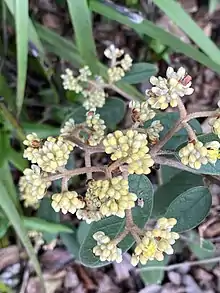| Pomaderris andromedifolia | |
|---|---|
.jpg.webp) | |
| In Heathcote National Park | |
| Scientific classification | |
| Kingdom: | Plantae |
| Clade: | Tracheophytes |
| Clade: | Angiosperms |
| Clade: | Eudicots |
| Clade: | Rosids |
| Order: | Rosales |
| Family: | Rhamnaceae |
| Genus: | Pomaderris |
| Species: | P. andromedifolia |
| Binomial name | |
| Pomaderris andromedifolia | |

Pomaderris andromedifolia is a species of flowering plant in the family Rhamnaceae and is endemic to south-eastern continental Australia. It is a shrub with lance-shaped to elliptic leaves and cream-coloured to yellow flowers.
Description
Pomaderris andromedifolia is a shrub that typically grows to a height of 1–2 m (3 ft 3 in – 6 ft 7 in) and has its young stems covered with woolly, rust-coloured hairs. The leaves are mostly lance-shaped to elliptic, 10–50 mm (0.39–1.97 in) long and 3–15 mm (0.12–0.59 in) wide, the upper surface glabrous and the lower surface with white to rust-coloured hairs. The flowers are borne in panicles on the end of branches and are cream-coloured to pale yellow, each flower on a pedicel 1.5–4 mm (0.059–0.157 in) long. The sepals are 2.0–2.5 mm (0.079–0.098 in) long but fall off as the flowers mature, the petals spatula-shaped and 1.5–2.5 mm (0.059–0.098 in) long. Flowering occurs from September to November.[2][3][4]
Taxonomy
Pomaderris andromedifolia was first formally described in 1825 by Allan Cunningham and the description was published in Barron Field's Geographical Memoirs on New South Wales.[5][6] The specific epithet (andromedifolia) refers to a similarity of the leaves of this species to those of the bog rosemary, Andromeda.[4]
In 1997, Neville Walsh described two subspecies of P. andromedifolia and the names are accepted by the Australian Plant Census:
- Pomaderris andromedifolia A.Cunn. subsp. andromedifolia[7] has straight hairs between the veins on the lower surface of the leaves and bracts that fall before the flowers open;[8][9]
- Pomaderris andromedifolia subsp. confusa N.G.Walsh & Coates[10] has curved or wavy hairs between the veins on the lower surface of the leaves and bracts that remain until flowering occurs.[11][12]
Distribution and habitat
Subspecies andromedifolia mainly grows in forest along the coast and tablelands from south-east Queensland, through New South Wales to far north-eastern Victoria,[8][9] but subspecies confusa is only known from south-eastern New South Wales and from collections in 2019 near Mallacoota in far north-eastern Victoria.[11][12]
References
- ↑ "Pomaderris andromedifolia". Australian Plant Census. Retrieved 23 December 2021.
- ↑ Harden, Gwenneth J. "Pomaderris andromedifolia". Royal Botanic Gardens Sydney. Retrieved 23 December 2021.
- ↑ Walsh, Neville G. "Pomaderris andromedifolia". Royal Botanic Gardens Victoria. Retrieved 23 December 2021.
- 1 2 "Pomaderris andromedifolia". Australian Native Plants Society (Australia). Retrieved 23 December 2021.
- ↑ "Pomaderris andromedifolia". Australian Plant Name Index. Retrieved 23 December 2021.
- ↑ Cunningham, Allan; Field, Barron (ed.) (1825). Geographical Memoirs on New South Wales. London: John Murray. p. 357. Retrieved 23 December 2021.
{{cite book}}:|first2=has generic name (help) - ↑ "Pomaderris andromedifolia subsp. andromedifolia". Australian Plant Census. Retrieved 23 December 2021.
- 1 2 Harden, Gwenneth J. "Pomaderris andromedifolia subsp. andromedifolia". Royal Botanic Gardens Sydney. Retrieved 23 December 2021.
- 1 2 Walsh, Neville G. "Pomaderris andromedifolia subsp. andromedifolia". Royal Botanic Gardens Victoria. Retrieved 23 December 2021.
- ↑ "Pomaderris andromedifolia subsp. confusa". Australian Plant Census. Retrieved 23 December 2021.
- 1 2 Harden, Gwenneth J. "Pomaderris andromedifolia subsp. confusa". Royal Botanic Gardens Sydney. Retrieved 23 December 2021.
- 1 2 Walsh, Neville G. "Pomaderris andromedifolia subsp. confusa". Royal Botanic Gardens Victoria. Retrieved 23 December 2021.